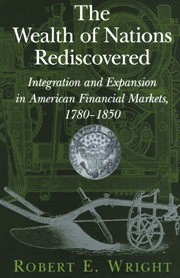 The Wealth of Nations Rediscovered
The Wealth of Nations Rediscovered Book contents
- Frontmatter
- Contents
- List of Tables
- Acknowledgments
- List of Abbreviations
- The Wealth of Nations Rediscovered
- 1 Introduction: The Wealth of Nations and National Wealth
- 2 The International and Colonial Background of America's Financial Revolution
- 3 Banks, Securities Markets, and the Reduction of Asymmetric Information
- 4 The Financial Sector and the Reduction of Lending-Related Costs and Risks
- 5 Evidence of Capital Market Integration, 1800–1850
- 6 Expansion of the Securities Services Sector, 1790–1850
- 7 The Freest of the Free: Regulation of the Financial Sector
- 8 Finance-Directed Economic Development
- 9 Conclusion
- References
- Index
4 - The Financial Sector and the Reduction of Lending-Related Costs and Risks
Published online by Cambridge University Press: 16 January 2010
- Frontmatter
- Contents
- List of Tables
- Acknowledgments
- List of Abbreviations
- The Wealth of Nations Rediscovered
- 1 Introduction: The Wealth of Nations and National Wealth
- 2 The International and Colonial Background of America's Financial Revolution
- 3 Banks, Securities Markets, and the Reduction of Asymmetric Information
- 4 The Financial Sector and the Reduction of Lending-Related Costs and Risks
- 5 Evidence of Capital Market Integration, 1800–1850
- 6 Expansion of the Securities Services Sector, 1790–1850
- 7 The Freest of the Free: Regulation of the Financial Sector
- 8 Finance-Directed Economic Development
- 9 Conclusion
- References
- Index
Summary
As shown in Chapter 3, new institutions (particularly commercial banks, but also insurance companies, savings banks, and brokerages) and new markets (primary and secondary debt and equity markets) reduced information asymmetry in the early U.S. economy. Those institutions and markets also reduced a number of other lending-related risks. In so doing, they increased the rate of investment by inducing more people to lend more money than they otherwise would have done. That, in turn, made more funds available for individuals and firms to borrow to improve their businesses through increased labor specialization, technological improvements, and/or exploitation of economies of scale and scope.
The new financial institutions decreased default risk, collateral risk, and term risk and thereby expanded the loan market. They decreased default risk by matching a pool of investors with a pool of entrepreneurs. In case of default, all investors paid a little, instead of one investor paying a large amount. They also decreased default risk by collecting information on borrowers and by becoming experts at assessing that credit information. Banks such as the Bank of Newburgh (New York), the Utica branch of the Ontario Bank (Canandaigua, N.Y.), the Mechanics' Bank (New York), and the BNA (Philadelphia) kept tabs on borrowers. Directors also made personal inquiries into the backgrounds of obscure or unknown loan applicants. Banks also collected third-party assessments of applicants via letter or endorsement. Additionally, banks obtained information by forging long-term relationships with some customers.
- Type
- Chapter
- Information
- The Wealth of Nations RediscoveredIntegration and Expansion in American Financial Markets, 1780–1850, pp. 43 - 81Publisher: Cambridge University PressPrint publication year: 2002


